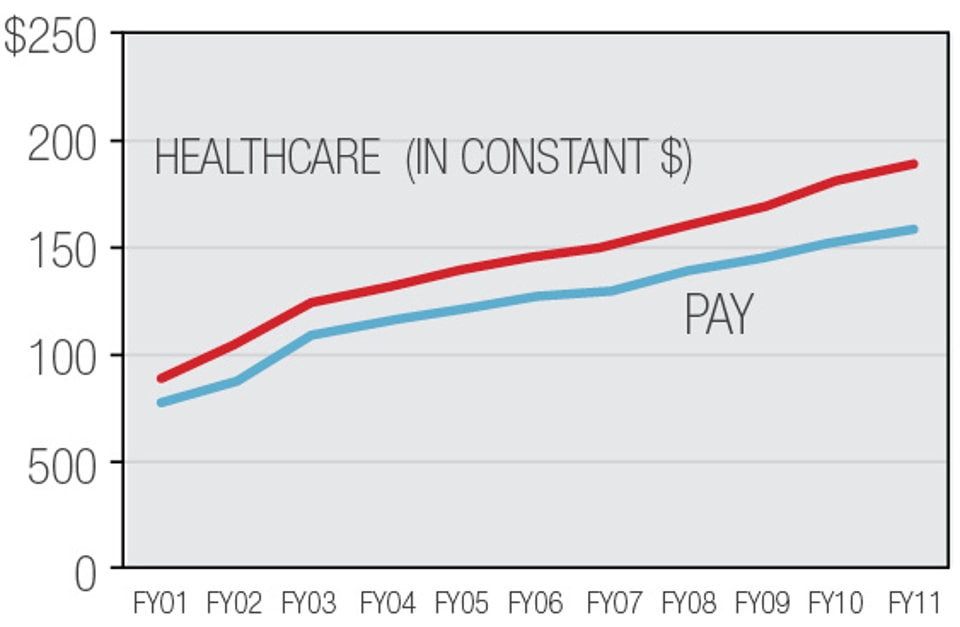Report Published February 5, 2013 · Updated February 5, 2013 · 5 minute read
Making the Case: How Obama's Defense Budget Strengthens Security
Mieke Eoyang
Takeaways
Despite what the critics would have you believe, the President’s FY2014 budget strengthens our national security because it:
- Provides robust spending levels for the military;
- Tackles long-term cost growth; and
- 3. Supports a flexible, modern military.
The President’s budget strengthens our national security by providing robust funding, tackling long-term cost growth, and giving us the modern, flexible force we need today—and in the future.
Robust Military Funding
The President requested $613 billion in national security funding, of which $526.6 billion is for the Department of Defense (DOD).1 This is roughly the same amount the White House requested last year.
- The budget would reverse the cuts imposed by sequestration, providing more robust funding for the military.
- Chief of Naval Operations, Jonathan Greenert, praised the budget’s investment in the future fleet, which “will deliver a fleet of 300 ships by 2019 with greater interoperability and flexibility when compared to today’s fleet."2
- General Martin Dempsey, Chairman of the Joint Chiefs of Staff, says the budget “protects investment in what I’ve often described as our real decisive advantage, and that is our people. It treats being the best-led, the best-trained, and the best-equipped military as the non-negotiable imperative."3
[This budget] treats being the best-led, the best-trained, and the best-equipped military as the non-negotiable imperative.
— General Martin Dempsey, Chairman of the Joint Chiefs of Staff, April 20134
Some critics single out the President’s budget because it is not under the sequester cut levels,5 but this charge misses the point. Our senior military leaders have testified to the devastating effects that sequestration will have on the military, and the President’s budget would reverse those cuts.
Tackling Long Term Costs
In this era of constrained budgets, rising costs in certain areas of DOD are crowding out other areas. Specifically, the price of health care and military compensation is rising faster than inflation. The President’s budget provides the groundwork to bring those costs under control so they don’t cripple our military later.
Military Health Care
The President’s budget is beginning to control rising military health care costs. As the largest employer in the country, DOD is affected by the rising cost of providing health care to its personnel and retirees.6 Most of DOD’s health care costs are driven by its retiree population, not those who leave short of 20 years and receive their care in the VA health care system.
The President’s budget includes a proposal to increase the TRICARE fee for working-age (under-65) military retirees. It would tie the fee to a percentage of the individual’s retired pay, capped at a certain amount. That percentage is rising over time, from 2.95% in 2014 to 4% in 2018.7
The President’s budget begins to tackle rising, long-term costs to prevent them from crippling our security later.
Military Compensation Reform
The President’s budget lays the groundwork to re-evaluate rising military personnel costs. DOD spends nearly a quarter of its budget on military personnel, primarily on pay and benefits.8
Personnel Cost Growth (Millions)9

These costs are increasing over time. If they are not brought under control, they will either compress other parts of the defense budget or force the military to do more with fewer people.
The Administration and Congress started the process of reviewing military compensation last year by creating the “Military Compensation and Retirement Modernization Commission,” which will spend up to two years studying military compensation and providing suggestions for improvements. Afterwards, Congress and the Administration can consider more comprehensive reforms.
Given the complexity of these problems, the Administration cannot tackle them alone. Congress should take this year to study how to reduce costs and improve efficiencies. Congress must also be a full partner in reform; if it is not, it will share the blame as neglect takes a further toll on the defense budget.
The President’s budget funds a modern, flexible military.
Funding a Modern, Flexible Military
Unlike after the collapse of the Soviet Union in the 1990s, the Administration isn’t just shrinking the size of our military, but reshaping it to create a modern, flexible force.
First, the military is moving away from Cold War-era legacy systems designed to fight the Soviet Union towards new technologies that can address threats posed by terrorists in hard-to-reach places, or cyberattacks from other adversaries.
- The Pentagon didn’t request any new M1 Abrams tanks and is greatly reducing the number of Army armored ground vehicles.10
- Instead, the budget provides for a robust arsenal of drones and increases funding for cyberspace operations by $800 billion.11
The task ahead for the department is to prepare for the future, but not in a way that neglects, or is oblivious to, the realities of the present.
— Sec. of Defense Chuck Hagel, April 10, 201312
Some legacy programs will be defended by their protectors in Congress, but the huge deficits we face mean that the U.S. will have to make some hard choices.
Second, the budget allows us to turn our focus to new challenges in Asia by reinvesting in our naval and air services.
- The budget includes robust funding for missile defense to address the threats from North Korean saber-rattling and Iran’s nuclear ambitions.
- The President’s strategy calls for a renewed focus on the Pacific to address the security challenges posed in that region. Pacific distances are great, so America will need to invest in air and sea capabilities.
- The budget includes increased funding for Virginia class submarines, C-130 cargo planes, and continued funding for next-generation aircraft carriers.
Finally, the Pentagon has conducted a “Strategic Choices and Management Review” to make sure we have the tools we need to deal with the threats we face now and in the future. This review informs future force structure and reductions for the Pentagon.
Conclusion
The President’s budget strengthens our national security by providing robust funding, tackling long-term cost growth, and giving us the modern flexible force we need today and in the future.
